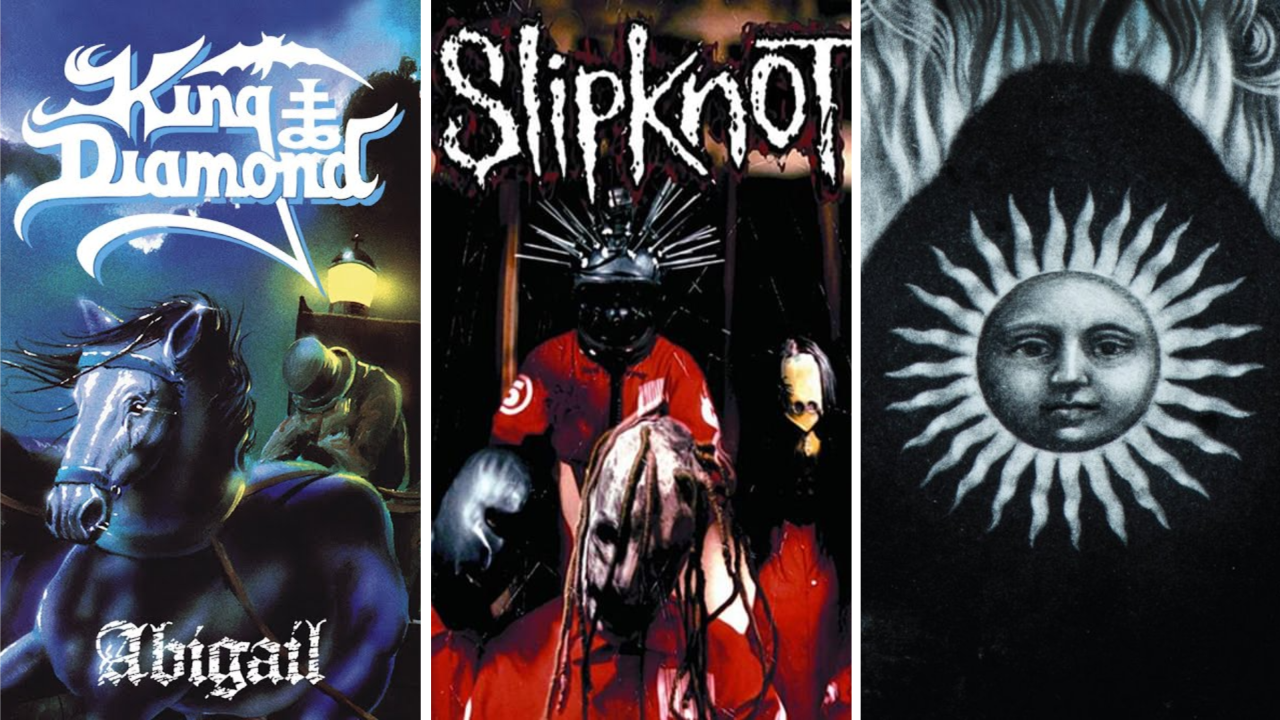
Roadrunner Records didn’t become heavy metal’s biggest label overnight. Although the imprint was founded in 1980, it wasn’t until its American office opened six years afterwards that it began to deal in properly seismic numbers. From that point until well into the 2000s, its A&R team had a seemingly psychic ability to sign bands right before they became massive: the likes of Slipknot, Machine Head, Type O Negative, Sepultura, Fear Factory and Trivium all earned megastardom while on the roster.
With Roadrunner now in its fifth decade of activity and releasing A+ tunes by everyone from Gojira to Code Orange, the catalogue has grown imposingly big. So, here’s the essential guide: Hammer has compiled the five albums that best demonstrate the history of this monolithic label.

King Diamond – Abigail (1987)
Abigail is when King Diamond became KING. FUCKING. DIAMOND! On his 1986 debut Fatal Portrait, the Danish dignitary was still nursing something of a Mercyful Fate hangover: ex-members Michael Denner and Timi Hansen played guitar and bass respectively. It’s also his sole solo album with no Andy LaRocque writing credits, and even the artwork looks rather Don’t Break The Oath-ish. Then, on Abigail, the King polished his crown.
Beyond his squealing falsetto and face-painted visage, everything you now associate with King Diamond debuted here. It’s the first of his 10 concept albums, LaRocque’s flashiness shines even brighter than before and the title track is the King’s most successful solo song. Plus, that overarching story is pure Victorian horror, spinning a yarn about murder and haunted mansions that would be echoed by follow-ups “Them” and Conspiracy. Abigail marked the first time a Roadrunner album ever charted in the United States and, for His Heavy Metal Majesty, affirmed he had his own distinct vision outside of Mercyful.
Sepultura – Beneath The Remains (1989)
Contrary to popular belief, Sepultura weren’t complete unknowns before signing to Roadrunner in 1988. Morbid Visions and Schizophrenia were fixtures of the underground tape-trading scene, to the point that they became a key influence on the Norwegian black metal movement and Max Cavalera was pen pals with Mayhem leader Euronymous. However, Beneath The Remains undeniably elevated the Brazilians into being standard-bearers of white-knuckle thrash.
Thanks to the move from shoe-string label Cogumelo to Roadrunner, Sepultura actually had a budget going into their third album. So, the teenagers from the slums of Belo Horizonte tapped death metal mastermind Scott Burns to produce. The result was a refined yet still-haunting sound that emphasised the band’s brutal intricacy. In the UK, the album reached number nine on the Independent Album Chart, while its creators began headlining tours across the States. It was the start of a commercial and critical climb that peaked when Max’s final Sepultura album, Roots, got certified gold in the US.
Machine Head – Burn My Eyes (1994)
Metallica’s Black Album and the rise of grunge sent the mainstream metal scene scattering like a nuclear bomb. The desperate search for the next big thing was on, with everything from Faith No More’s funk metal to the groove of Sepultura getting major airplay. Machine Head elbowed their way to prominence in this pre-nu metal scramble by taking thrash, slowing it down, making it brazenly sociopolitical and injecting some hip-hop swagger.
Lifted by the sheer muscle of Davidian and A Thousand Lies, Burn My Eyes was an instant starmaker. Lyrics about the Waco siege and the 1992 L.A. riots made it a timely explosion of angst. Meanwhile, Robb Flynn’s cornrows and punk rock pinch harmonics made extreme metal look – dare we say it – cool. Machine Head boasted legitimate crossover appeal as a result, and Burn My Eyes became the best-selling debut album in Roadrunner history. It retained that honour for five years, until some gaggle of masked lunatics rocked up…
Slipknot – Slipknot (1999)
You already know how brilliant Slipknot is. Its story is woven into the tapestry of heavy metal lore: nine misfits from Iowa were so pissed off about where they lived that they wrote nu metal tantrums loud enough that even Roadrunner heard. The label signed them to a ridiculously long seven-album deal, but The Nine were a buzz band before they even released a note, thanks to a series of incendiary shows on the 1999 Ozzfest tour.
When Slipknot finally came out, it was the perfect storm of attention-demanding imagery (apart from that shitty gimp mask Jim Root quickly swapped out) and furious music. The rapping and ferocious percussion tapped into nascent millennial angst, rocketing the band to number one on the US Heatseekers chart. Today, Slipknot are a heavy music institution, custodians of their own festival and the inspiration for countless metalhead tattoos – but they still haven’t outdone the debut that first wrecked stereo speakers more than two decades ago.
Gojira – Magma (2016)
Magma is when Gojira went from being you and your mates’ favourite underdogs to legitimate arena stars. By the time the death metal kaiju signed to Roadrunner for 2012’s L’Enfant Sauvage, a 15-year career making masterpieces like From Mars To Sirius and The Way Of All Flesh had already made them cult heroes. Yet those albums were deemed far too technical to ever penetrate the mainstream.
On Magma, Gojira softened without selling out. Such anthems as Stranded and Silvera boasted simpler heavy metal hooks, but did so purely because the band wanted easier songs they could play on the road until they’re old men. Meanwhile, the stoner rock melodies of The Shooting Star were sung in tribute to Joe and Mario Duplantier’s mother, who died in 2015. The accessibility let the wider world figure out what the underground had long known: Gojira are the fucking best. They ended 2016 supporting Alter Bridge in European arenas and have only grown more and more powerful ever since.







